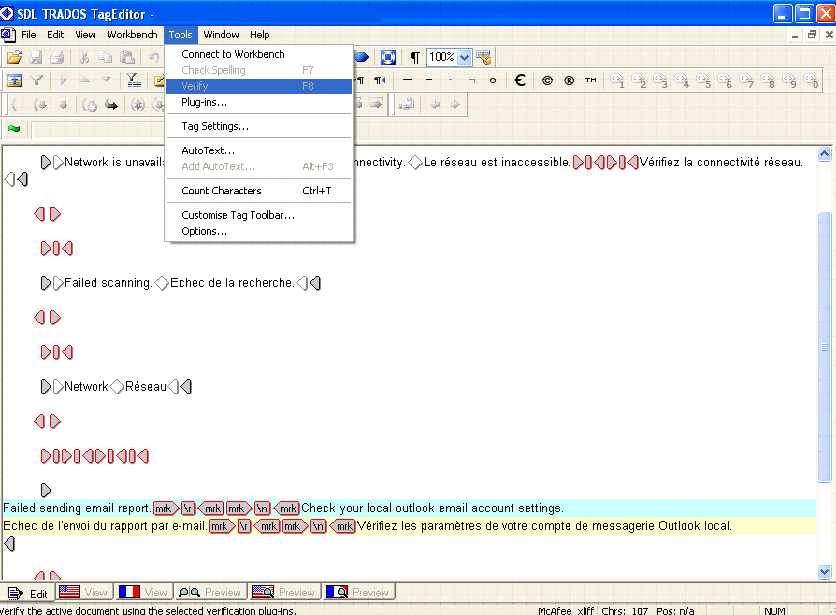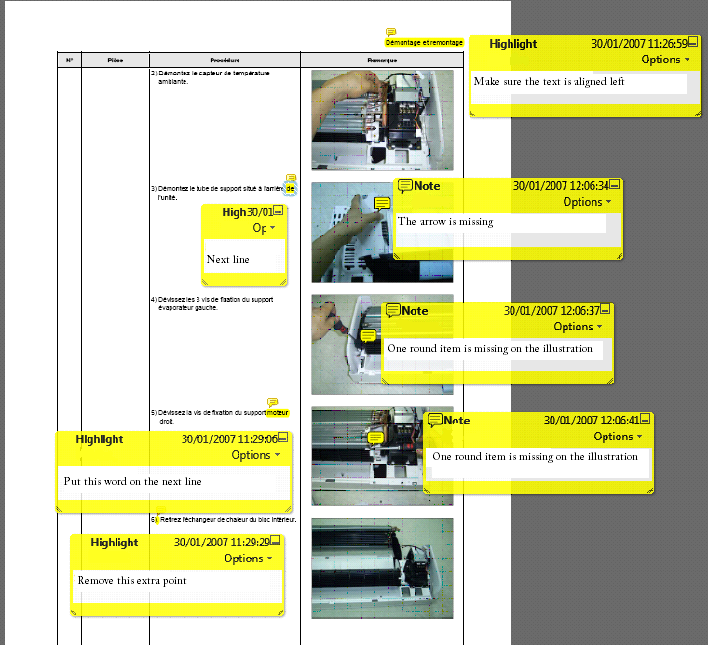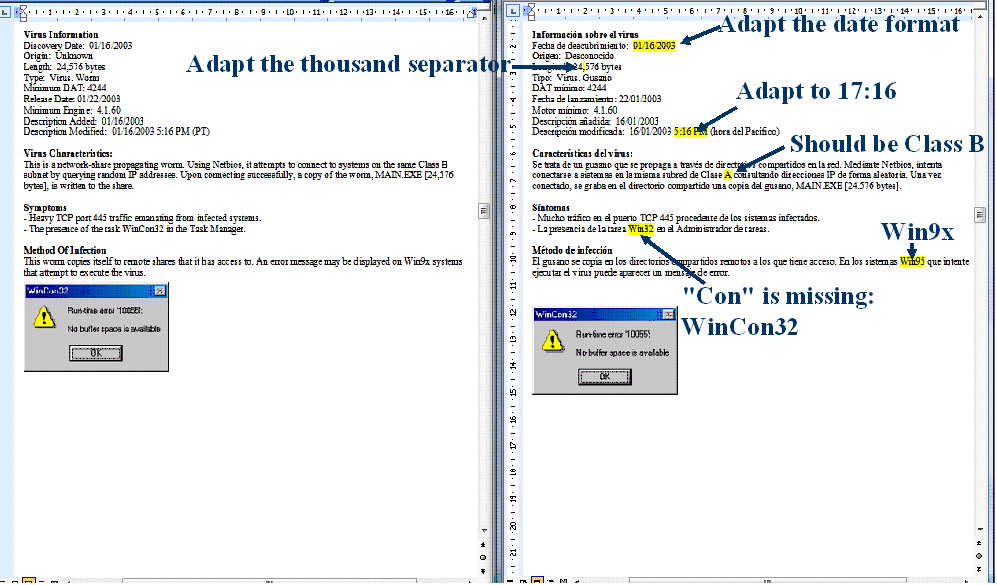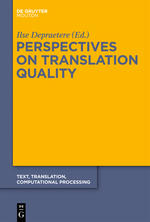Quality Assurance in the translation workflow – A professional’s testimony
Quality Assurance in the translation workflow – A professional’s testimony Baudouin 星期四, 08/03/2017Publication: Matis, Nancy (2011), "Quality Assurance in the translation workflow – A professional’s testimony". Ilse Depraetere (ed), Perspectives on Translation Quality. Berlin: De Gruyter Mouton, 2011, ISBN 978 3 11 025984 1.
Comment
Quality Assurance in the translation workflow – A professional’s
By Afaf (未验证) on 星期二, 08/25/2020- 永久连接
Link
By Nancy Matis on 星期一, 01/13/2025- 永久连接
Afaf (未验证) 回复 Quality Assurance in the translation workflow – A professional’s
Sure, you can find it here:
https://www.degruyter.com/document/doi/10.1515/9783110259889.147/html?l…
Introduction
IntroductionIn the translation process Quality Assurance (QA) usually takes place at the end of the workflow. It includes all of the actions and processes that are implemented to ensure that the project is totally in keeping with the customer’s requirements. The QA phase entails checking the linguistic quality of the translation and, in some cases, an evaluation of various technical criteria. The actual QA process itself will vary according to several factors, such as the customer’s requirements, the human resources assigned to the project (translators, reviewers, etc.), the amount of time which can be devoted to QA and even the budget allocated to this latter task. The purpose of this article is to briefly present various QA processes that can apply to standard translation projects or to software, web site and other e-content localisation projects. For the purposes of this article we will limit our examples to simple translation projects.
Quality Assurance in translation projects
Quality Assurance in translation projects Baudouin 星期日, 06/18/2017Types of QA
Types of QAQA can be either linguistic or technical.
Linguistic QA focuses on achieving the quality targets set for the translated text to ensure that the linguistic quality of the final document is of a high standard — and in particular meets the criteria defined by the customer — so that it is easy to read and understand by the target audience.
Technical QA, on the other hand, applies to the technical aspects of a translation or localisation project. For example, if the document must conform to a specific layout, the QA process will involve ensuring that the layout requirements are met — e.g., the target layout matches the source layout — and meet the customer’s specifications. In the case of software localisation, technical QA will entail ensuring that the localised version of the software is ready for market; that the testing/compilation/debugging phases have been properly carried out; that the future users of the software will be comfortable with the software in the target language, etc. Other localised e-content material, such as help files, web sites, Flash animations1, etc., also require a technical QA phase to ensure that the content performs as expected, is free of bugs (or at least contains an acceptable level of non-critical bugs), matches the original layout, is easy to use for the target audience, etc.
- 1. Graphic animations created using Adobe Flash, for instance, and viewable with the Flash Player plug-in.
Duration of the QA phase
Duration of the QA phaseThe duration of the QA phase will depend on the number of steps involved in the project, the complexity of the project and various other factors.
In general, the actual translation phase is followed by a revision phase during which reviewers check the translation against the original text to ensure that the terminology is appropriate, the customer’s requirements have been met, spelling and grammar are correct, text flows naturally and is adapted to the target audience (in terms of style, cultural references and register), etc. The revision phase may be directly followed by a linguistic QA phase.
In the case of documentation, for instance, the linguistic QA phase will be followed by a DTP (desktop publishing) phase in which the target document is formatted to match the original layout in terms of font type, size and colour, paragraph and line breaks, character spacing, alignment, bulleted lists, illustrations, etc.). Once the DTP phase is completed, “DTP QA” will be performed to ensure that the target layout matches the original layout, in line with the customer’s requirements.
In some cases, to save time, the two previously mentioned QA phases may be combined, in which case the document would first be DTPed and then linguistic and DTP QA performed at the same time. Thus, QA tasks might first be performed by a linguist then immediately afterwards by someone else with a more technical profile. However, both sets of tasks may well be performed by the same person (for instance a senior translator) if they are sufficiently qualified to do so.
Finally, for various reasons, the QA phase of the translation project may be omitted altogether.
Deciding whether or not QA should be performed depends on several factors,
among which:
- Type of project: very easy, small projects might not require a QA phase. A linguistic review may suffice, or one could even assume that the translator alone can guarantee the quality of the translation. In some cases, when the layout work has been carried out by technically proficient DTP staff, DTP or illustration checks may not be needed.
- Subject of the project: most translated content will usually require revision, but in some cases linguistic QA may not be required, e.g., a technical translation in which the reviewer has strong technical and linguistic skills.
- Customer: some customers are extremely demanding and insist on the highest standard of quality; some may even require evidence that the various types of QA tasks have been performed during the project. Others may focus less on quality but more on prompt delivery, for instance when a quick translation is needed for internal communication.
- Volume: the larger projects are, the more difficult it is to guarantee uniform quality and consistency. Indeed, large projects usually require the involvement of several people. For example, in a large translation project, the actual translation work may be assigned to 12 translators, the revision phase to 3 reviewers and the DTP phase to 3 people. In this case, linguistic and DTP QA will not only help to improve quality but will also ensure greater consistency in the work produced by the various participants.
- Resources: if the translation or revision phases are assigned to highly experienced linguists, who have worked for a long time for the same customer and/or on the same subject, a linguistic QA phase might be superfluous. The same applies to highly experienced DTP staff, whose work may not need to be double-checked.
- Schedule: implementing QA sometimes requires extending deadlines. Unfortunately, it is not always possible to extend a project deadline, in which case the QA phase may have to be omitted.
- Budget: QA costs money. People performing QA tasks have to be paid, and on certain projects, in light of the QA results, some of the work may need to be done again. Additional steps will always mean additional costs, and in some cases they will simply not be possible due to budget limitations.
Material used during the QA phase
Material used during the QA phaseThe material used during the QA phase is generally quite similar to the material used during the other phases of the project. It may vary from one QA person to another since personal preferences can also impact on the way QA is performed.
- On screen or hard copy: when performing linguistic QA, some people prefer to print all of the documents. This is also the case for DTP QA. Indeed, in some cases, it is easier to spot a problem when the documents are printed rather than checking them on screen, as documents are not always displayed in their real size. On the other hand, with software such as Adobe Acrobat Pro, QA staff can easily insert comments on PDF files, in which case it would be a clear advantage to work on screen.
- Glossaries: it is important to know which glossaries have been used by the translators and reviewers so that the same ones can be used. Obviously, other specialised glossaries can also be used.
- Customer’s website: for customers with multilingual websites, it may also be of help to cross-check the translation with the local websites to ensure consistency of terminology, style and even the naming of products.
- Reference material from the customer: normally at the QA stage, one can assume that all of the customer’s instructions have been followed and that the customer’s preferences have been taken into account. Still, if the QA person wants to double-check certain points, it is important that they have all of the material used by the other project participants, such as customer glossaries, customer style guides, specific instructions, previous customer feedback, etc.
- Source language material: when QAing translated texts, some people prefer to focus on the target material without referring to the source content. However, from time to time, the source material may be needed to check sources of potential problems. Other QA staff, on the other hand, prefer to compare the entire target content against the source to ensure that no meaning has been lost. When performing technical QA, for instance when checking the layout of a target document, it is generally preferable to compare against the source to ensure that layout is respected. When QAing Flash animations, it is also important to compare the translated version against the source animation since there are usually special visual effects that will need to be identical.
- Translation Memories (TMs1): TMs may or may not be used during the linguistic QA phase. Normally, the text should already have been revised, so the TM may no longer be needed. Still, some QA personnel who are used to TM processes prefer to continue working with the TM segments or even use the TM for the its Concordance features2.
- Previous projects: if possible, the translation of a previous version of the document or software may be used to double-check that the new translation is consistent with it.
- QA tools: some software applications have been developed specifically for QA purposes. Thus, tools have been developed which can automatically detect inconsistencies or grammar and spelling mistakes, or broken links in compiled help files or websites3.
- 1. Translation Memories are a category of Computer-Aided Translation tools. The principle is to save each source segment (part) of a text together with its corresponding translation in a database. Whenever a source segment identical to one previous saved in the database appears in the same document or in another text, the TM tool will propose the stored translation. If the source segment is not exactly the same but is similar, the stored translation will still be proposed, but with some indication as to how the new source segment differs from the stored source segment so that the proposed translation can be modified accordingly.
- 2. Feature allowing the user to search a TM for all occurrences of a term/phrase to check how it has been translated in the past; especially useful if the translation can vary according to the context.
- 3. Examples of QA tools: QA Distiller (Yamagata), HTMLHelpQA (SDL), as well as various components or plug-ins within existing software, such as the Tag Verifier plug-in included in SDL Trados TagEditor.
Levels of QA
Levels of QADepending on the factors mentioned above, the QA process may be very quick and general, or on the contrary, extensive and very precise.
For instance, linguistic QA may comprise the following levels:
- “End User” QA: the person performing the QA tasks assumes the role of an end user of the translated product, be it a document, a website, software, animations, etc. Their role would be to ensure that, when using the target material at “normal” speed, the content is easy to understand, the text flows smoothly and logically. The source material will only be checked when hesitations occur or problems arise.
- Sample QA: due to various constraints, it may not always be possible to QA the entire project. In many cases, customers or translation companies require that QA be performed on only a certain percentage of the project. General QA could then be performed on this sample using the “End User” QA model mentioned above. Alternatively, the entire project may need to be rechecked. In this case, if linguistic QA is to be performed, it could entail rechecking the entire translation against the original file, checking the terminology, style, grammar, spelling, etc. The QA person may also simply consider that everything has already been checked by the reviewer and would therefore quickly compare the target and source texts, without rechecking every single aspect of the translation.
- Extended QA: in some cases, due to the complexity or size of the project, it is important that a complete (but not necessarily detailed) recheck be performed. This could entail tasks such as:
- Quick reading of the target text to ensure that it flows smoothly and does not contain any unclear sections
- Quick checking of all translated segments against the source text (with or without a Translation Memory) to ensure that they have been correctly translated
- Automatic spell checking using a Spell Checker
- Quick manual grammar check
Technical QA may also be broken down into several levels. For instance, QAing the layout of a target document could involve:
- Sample QA: checking only a few pages to ensure that the client’s instructions have been followed, and that the target layout matches the original.
- Full QA: checking of all pages to ensure that every single page is consistent with the original layout and specific instructions.
- Extended QA with limited linguistic check: during DTP QA, this could entail checking items within the target text that do not necessarily require knowledge of the target language. In this case, while ensuring that the page layout is correct, the person performing the QA would also check the following points:
- Figures: they should normally be similar to those indicated in the original text
- Proper nouns: nouns appearing in the target text should match the original ones
- Items to be localised:
- thousand and decimal separators should be adapted to the local language: 112,000.25 in US English becomes 112 000,25 in French
- currencies sometimes need to be adapted to the local audience: USD 10 becomes 7 EUR
- names of some organisations or acronyms sometimes need to be localised: UNO in English becomes ONU in French
- URLs may need to be adapted if local websites exist: http://www.website.us becoming http://www.website.fr
- Punctuation may need to be changed: double spaces after a full-stop in English becoming a single space in French
- etc.
- Internal formatting: if some parts of the source text are formatted in bold, italics, underline, etc., the corresponding target parts of text should generally be formatted in the same way.
- Special symbols: symbols such as ©, ®, ™, etc., should generally be used in the same way in the target text.
- Complete translation: even without knowledge of a specific target language, it is sometimes possible to check that everything has been translated. Indeed, when working with some specific formats, headers, footers, captions of illustrations, parts of the Table of contents, etc. may not be fully translated. This can also be checked during Extended DTP QA.
- Etc.
Persons assigned to QA
Persons assigned to QAWho to assign to QA? This is a question that many project managers will ask themselves when managing the various steps of their projects.
In most cases, linguistic QA is performed by senior translators who know the subject very well and/or are very familiar with the customer’s projects. Field experts, who, without being translators, would easily be able to spot errors of meaning in a translated text, could also be recommended for linguistic QA.
Where technical QA is concerned, the choice of person depends on the complexity of the tasks to be performed. For instance, for DTP QA, a graphic expert could be asked to QA the final files. Still, in many cases, translators are also required to perform such QA tasks, which are quite different from the actual translation of a text. These QA tasks could entail checking that the target layout is the same as the original layout, that all of the source text has been translated, that headers and footers have not been omitted, that the page numbers are correct, that the titles and page numbers listed in the Table of contents match the actual section title and page numbers, etc. Translators are generally quality focused and are usually quite good at checking all of these details, which could significantly improve the quality of a guide.
Forms
FormsVarious forms can be used during a translation project and can be reused during the QA phase. Other forms are specific to the QA process.
Checklists
ChecklistsThese list all of the items to be checked for a certain type of task. They differ according to the type and level of QA. For instance, checklists may be drawn up for QAing illustrations or Flash animations in detail, others for QAing layout and specific linguistic aspects of target texts, and others for extended linguistic QA for specific customers and subject areas.
Some checklists can be very general in scope, and applicable to nearly all projects and project components. Others may be developed for a specific subject area or project component. It is also possible to use the same general checklists for all projects, adapting them as needed on a project-by-project basis by simply appending new items at the end.
The checklists may be provided by the customer, but in some cases they may need to be drawn up by the translation team itself. From time to time the customer may even require that the completed checklists be sent together with the target translation. Indeed, marking off each point as proof that it has been checked could reassure the customer as to the quality of the work.
Here is an example of a General checklist adapted for a specific project:
| General Checklist | Checked | NA |
|---|---|---|
| Product-specific glossary used | ||
| Style is homogenous and follows customer's guidelines | ||
| Terminology is consistent | ||
| Phone numbers, URLs, Web sites, on-line services and all hyperlinks are checked and tested if needed | ||
| Formatting is consistent with the customer’s standard guidelines | ||
| Legal information (e.g. copyright page) are correct according to customers' instructions | ||
| All art and call-outs are translated and consistent with the text | ||
| Headers and footers are translated correctly and consistently | ||
| Time, date, currency, number format, and measurement units are correct according to specific country standards or customer’s guidelines | ||
| All text is translated (except where specifically indicated to the contrary) | ||
| Grammar, syntax, and punctuation correspond to target language standards | ||
| Spell check done | ||
| Files saved in the right format using the right name | ||
| Specific Checklist for the project | Checked | NA |
| Product names are not translated | ||
| Checking of OS options performed against a MAC platform | ||
| ... |
Evaluation forms
Evaluation formsQA items can be rated for an objective indication of whether the work is acceptable or not.
The evaluation form templates may or may not be provided by the customer, who may also ask for the completed forms at the end of the project to ensure that evaluations were performed and that the final quality conforms to required standards. Some customer may even perform the QA evaluation themselves.
The forms may be quite general, with simple ratings, or on the contrary, very detailed, indicating all of the issues to be resolved, and even the proposed corrections to be implemented before final delivery.
Here is an example of a General Evaluation form:
| LINGUISTIC QA FORM | |
| Omissions | /5 |
| Language understanding | /5 |
| Subject understanding | /5 |
| Terminology | /5 |
| Grammar | /5 |
| Style & Word choice | /5 |
| Spelling & Typos | /5 |
| Presentation | /5 |
| Respect of client's rules (style guide, glossary, guidelines) | /5 |
| Global evaluation | /5 |
Examples
Examples MSurreau 星期二, 08/01/2017Extended Linguistic QA
Extended Linguistic QA
In this case, all of the segments will be checked using this Computer Aided Translated (CAT) tool. The person performing the QA tasks will probably trust the reviewer for terminology and observance of the customer’s preferences, but they will perform a check to ensure that everything makes sense and is correctly translated. Due to the format of the file, they will also ensure that the tags (format markers appearing within the text, such as “mrk”, “\r”, etc.) present in the source segments have been left in the right place in the target segments.
DTP QA
DTP QA
The various annotations indicate the layout issues detected when the target layout was checked against the source layout.
QA with limited linguistic check in an unknown language
QA with limited linguistic check in an unknown language
During this type of QA, it is important to ensure that figures are correct and that dates and times conform to local standards. Moreover, as shown in the illustration, product names should not be changed. All of these points can easily be checked, even without knowledge of the language.
Conclusion
ConclusionSome people consider that QA is an essential phase of any translation project.
Others simply assume that QA will not improve the project in any significant way. Indeed, one could argue that everyone involved in a project should perform their tasks to the highest quality standards, and therefore no QA should be required.
Many factors therefore need to be taken into account when deciding whether or not QA should be performed. After weighing the pros and cons for a specific project, one can then decide whether or not it is worthwhile performing one or several types of QA, and to which extent.
In any case, if QA is performed by competent staff, it will generally help to improve the quality of the project, or at least guarantee that quality has already been achieved, which is obviously also essential in any quality process.



Hello,
I would love to have a deeper look at the book.
Thanks a lot,
Afaf